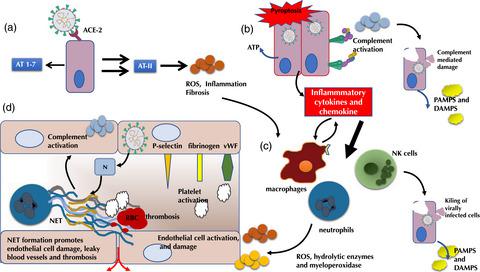当前位置:
X-MOL 学术
›
Clin. Exp. Immunol.
›
论文详情
Our official English website, www.x-mol.net, welcomes your
feedback! (Note: you will need to create a separate account there.)
Innate immunity during SARS‐CoV‐2: evasion strategies and activation trigger hypoxia and vascular damage
Clinical & Experimental Immunology ( IF 3.4 ) Pub Date : 2020-09-26 , DOI: 10.1111/cei.13523 S Amor 1, 2 , L Fernández Blanco 1 , D Baker 2
Clinical & Experimental Immunology ( IF 3.4 ) Pub Date : 2020-09-26 , DOI: 10.1111/cei.13523 S Amor 1, 2 , L Fernández Blanco 1 , D Baker 2
Affiliation

|
Innate immune sensing of viral molecular patterns is essential for development of antiviral responses. Like many viruses, SARS‐CoV‐2 has evolved strategies to circumvent innate immune detection, including low cytosine–phosphate–guanosine (CpG) levels in the genome, glycosylation to shield essential elements including the receptor‐binding domain, RNA shielding and generation of viral proteins that actively impede anti‐viral interferon responses. Together these strategies allow widespread infection and increased viral load. Despite the efforts of immune subversion, SARS‐CoV‐2 infection activates innate immune pathways inducing a robust type I/III interferon response, production of proinflammatory cytokines and recruitment of neutrophils and myeloid cells. This may induce hyperinflammation or, alternatively, effectively recruit adaptive immune responses that help clear the infection and prevent reinfection. The dysregulation of the renin–angiotensin system due to down‐regulation of angiotensin‐converting enzyme 2, the receptor for SARS‐CoV‐2, together with the activation of type I/III interferon response, and inflammasome response converge to promote free radical production and oxidative stress. This exacerbates tissue damage in the respiratory system, but also leads to widespread activation of coagulation pathways leading to thrombosis. Here, we review the current knowledge of the role of the innate immune response following SARS‐CoV‐2 infection, much of which is based on the knowledge from SARS‐CoV and other coronaviruses. Understanding how the virus subverts the initial immune response and how an aberrant innate immune response contributes to the respiratory and vascular damage in COVID‐19 may help to explain factors that contribute to the variety of clinical manifestations and outcome of SARS‐CoV‐2 infection.
中文翻译:

SARS-CoV-2 期间的先天免疫:逃避策略和激活引发缺氧和血管损伤
病毒分子模式的先天免疫感应对于抗病毒反应的发展至关重要。与许多病毒一样,SARS-CoV-2 已经进化出规避先天免疫检测的策略,包括基因组中的低胞嘧啶-磷酸-鸟苷 (CpG) 水平、糖基化以屏蔽包括受体结合域在内的基本元素、RNA 屏蔽和生成积极阻碍抗病毒干扰素反应的病毒蛋白。这些策略共同导致了广泛的感染和病毒载量的增加。尽管做出了免疫破坏的努力,SARS-CoV-2 感染仍激活先天免疫途径,诱导强烈的 I/III 型干扰素反应、促炎细胞因子的产生以及中性粒细胞和骨髓细胞的募集。这可能会引起过度炎症,或者有效地招募适应性免疫反应,帮助清除感染并防止再次感染。由于 SARS-CoV-2 受体血管紧张素转换酶 2 的下调,导致肾素-血管紧张素系统失调,加上 I/III 型干扰素反应的激活,炎症体反应汇聚促进自由基产生和氧化应激。这加剧了呼吸系统的组织损伤,但也导致凝血途径广泛激活,导致血栓形成。在这里,我们回顾了目前关于 SARS-CoV-2 感染后先天免疫反应作用的知识,其中大部分是基于 SARS-CoV 和其他冠状病毒的知识。了解病毒如何破坏最初的免疫反应以及异常的先天免疫反应如何导致 COVID-19 中的呼吸和血管损伤,可能有助于解释导致 SARS-CoV-2 感染的各种临床表现和结果的因素。
更新日期:2020-10-30
中文翻译:

SARS-CoV-2 期间的先天免疫:逃避策略和激活引发缺氧和血管损伤
病毒分子模式的先天免疫感应对于抗病毒反应的发展至关重要。与许多病毒一样,SARS-CoV-2 已经进化出规避先天免疫检测的策略,包括基因组中的低胞嘧啶-磷酸-鸟苷 (CpG) 水平、糖基化以屏蔽包括受体结合域在内的基本元素、RNA 屏蔽和生成积极阻碍抗病毒干扰素反应的病毒蛋白。这些策略共同导致了广泛的感染和病毒载量的增加。尽管做出了免疫破坏的努力,SARS-CoV-2 感染仍激活先天免疫途径,诱导强烈的 I/III 型干扰素反应、促炎细胞因子的产生以及中性粒细胞和骨髓细胞的募集。这可能会引起过度炎症,或者有效地招募适应性免疫反应,帮助清除感染并防止再次感染。由于 SARS-CoV-2 受体血管紧张素转换酶 2 的下调,导致肾素-血管紧张素系统失调,加上 I/III 型干扰素反应的激活,炎症体反应汇聚促进自由基产生和氧化应激。这加剧了呼吸系统的组织损伤,但也导致凝血途径广泛激活,导致血栓形成。在这里,我们回顾了目前关于 SARS-CoV-2 感染后先天免疫反应作用的知识,其中大部分是基于 SARS-CoV 和其他冠状病毒的知识。了解病毒如何破坏最初的免疫反应以及异常的先天免疫反应如何导致 COVID-19 中的呼吸和血管损伤,可能有助于解释导致 SARS-CoV-2 感染的各种临床表现和结果的因素。











































 京公网安备 11010802027423号
京公网安备 11010802027423号